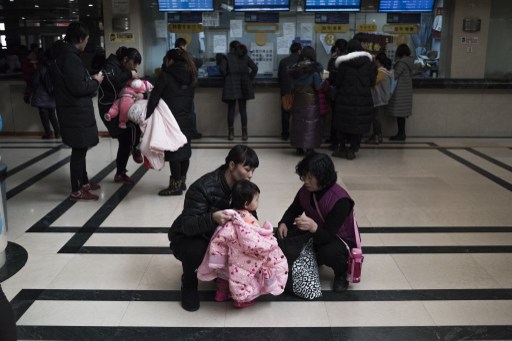
A mother and a grand-mother take care of a child in Beijing on January 1, 2016. Married couples in China have been allowed since January 1 to have two children, after concerns over an ageing population and shrinking workforce ushered in an end to the country’s controversial one-child policy. AFP FILE PHOTO
PARIS, France—The end of China’s one-child-per-couple limit last year will not provide the population boost sought by Chinese leaders in the near term, according to a study released Friday.
Any potential benefits the new “two-child” rule might have for the nation’s shrinking workforce and rapidly ageing population will not be felt for at least two decades, the study concluded.
China is faced with deep demographic challenges thanks to the strict — and sometimes brutal — enforcement of its single child policy, introduced in 1979 at the end of the Mao Zedong era.
The new rules will “allow most people to have their desired number of children and help address the skewed sex ratio,” said Therese Hesketh, a researcher at University College London and co-author of the study, published in The Lancet.
The two-child limit will also reduce the number of abortions of unapproved pregnancies, and could eliminate the problem of unregistered children, she said in a statement.
READ: China’s new two-child policy law takes effect
“But the effect on population ageing and the shrinking workforce will take longer to be felt.”
China has 220 million people 60 or older, accounting for over 16 percent of its total population, the government said in July.
The country’s workforce is on track to decline by as much as 23 percent by 2050.
The retirement age is 55 for women, and 60 for men.
The most populous nation on Earth, China counted 1.37 billion people at the end of 2015.
The one-child policy was introduced by top leader Deng Xiaoping to curb population growth and promote economic development.
The result was dramatic: fertility rates dropped from 5.9 births per woman in 1970 to about 1.6 in the late 1990s.
Concerns mounted about demographic imbalance, but Chinese leaders hesitated to simply abolish the one-child policy, fearing it would lead to a population explosion.
As a half-way measure, they allowed parents who were themselves only-children to have two of their own.
But by May 2015, only 1.45 million couples — less than 15 percent of those eligible — applied to have a second child.
READ: China’s population to grow 45 million by 2020–plan
In October last year, the two-child policy was made universal.
One of the perverse effects of the one-child policy — coupled with the introduction of medical ultrasound technology — was a sharp rise in the abortion of unwanted female foetuses.
On current trends, the report said, there will be more than 30 million “unmarriageable” men in China by 2020.

